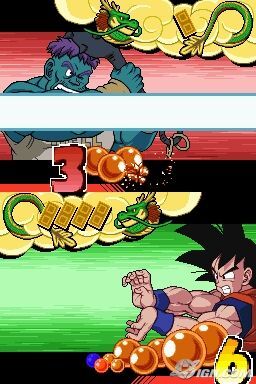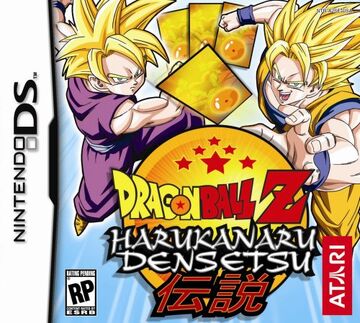Dragon Ball Z: Harukanaru Densetsu, known as Dragon Ball Z: Harukanaru Goku Densetsu (ドラゴンボールZ 遥かなる悟空伝説, Doragon Bōru Zetto Harukanaru Gokū Densetsu, lit. Dragon Ball Z: The Distant Legend of Goku) in Japan and Dragon Ball Z: Goku Densetsu in Europe, is a card-based role-playing game for the Nintendo DS.
Overview
The game takes place from the beginning of the Saiyan Saga to the end of the Cell Games Saga (like Dragon Ball Z Kai, before their decision to continue with the Buu arc). Players choose from one of the four main characters, Goku, Gohan, Piccolo, and Vegeta. Most characters of the playable sagas appear, but only as either enemies or support cards.
The game story seems to be a fusion of the first three DBZ NES games (with the complete version of the third game which ended at the battle between Cell and Piccolo), as this is the sixth (after Dragon Ball Z: Super Saiya Densetsu not counting DB for wonderswarn color) Cardbased game.
Gameplay

Each mission is usually broken down into a few key objectives, each mission taking anywhere from 5 to 30 minutes to complete. The game is based on levels, the more fights the player wins, the more experience is received, which in turn makes the player's attacks stronger. In battle, the highest attack power of a card wins; however, the player can also combine cards to create combination effects. For example, if in possession had 3 cards with a power rating of 7, these can be combined to create a 21 power card, which would most likely out-do the opponent's cards. The player can also combine defense in the same way. There are also different types of cards: power and defense who raise the stats of the cards in the player's hand, item cards, escape cards or counter cards which swap the power of the player's card with the enemy's. The player moves around the game in a boardgame-like manner. The story begins in the Saiyan Saga and continues until the end of the Cell Games Saga.
There is also a multiplayer mode on the game which uses local Wi-Fi, in which the player can duel against a human opponent.
Types and Effects of the Cards

The attack power of a card is represented by the number of stars located in a Dragon Ball drawn in the card, a one-star being the weakest attack and seven the second most powerful one (the attack level go from 1 to 7 stars and then, the Z one is the strongest category). The defense level works the same way, but only numbers are used (although it states the Z like a level). The cards are classified as:
- Strike Cards: They Cause damage to the opponent and they are the first ones that are learned.
- Energy Cards: They increase the attack power of the cards, and they are only important if they have a high attack level (To make all the cards of the deck go up to a Z attack level).
- Training Cards: They Act the same as the energy cards , but they ascend the defense.
- Use Cards: They allow to use objects that are gathered during the game.
- Z Cards: They can be used for anything in the course of the battle.
- Running Cards: They allow the player to escape a battle.
- Friend Cards: They serve as an Attack that another character performs for the player, other than the one being used in the current battle.
- Reverse Cards: They switch the attack power of the card with the rival's power.
Characters
Playable Characters
These characters are the ones the player can move around the board with and fight as, also the only ones if their own scenario. Their outfits change frequently to match what they look like in different sagas.
Support Characters
These characters are not playable, but are available as a Friend Card. They are listed in order of weakest to strongest. Most of them usually have a role in the story.
In the Map |
In Battle |
Enemy Characters
Major characters the player has to face. Also known as bosses, the main ones are Raditz, Nappa, Vegeta, the Ginyu Force, Frieza, the Androids and Cell. There are also many other minor enemies and henchmen the player has to fight along the way, usually associated with the part of the story that is currently played or with the scenario played with a certain character.
Enemies
Bosses
|
|
|
Other Characters
Characters that appear in the Saiyan Saga to the end of the Cell Games Saga in the Dragon Ball manga or in Dragon Ball Z appear in the game as a Non-Playable Characters, such as King Yemma, the Guide, Princess Snake's Attendants, King Kai, Bubbles, Gregory, Turtle, the blonde nurse from Wukong Hospital, Moori, Dende, Grand Elder Guru, Porunga, the Yardrats, Future Trunks, Trunks, Dr. Brief, and Mr. Satan.
Items
|
|
Reception
Reception in Japan was good. It was near the top of the best selling charts, and reviews were positive or mixed, with only a few negative. Critics were glad not to see a complex fighting game like Dragon Ball Z: Budokai Tenkaichi 2, while a little disappointed at the simplistic gameplay.
In America, the game was not as popular, but came in third place for its first week of release, only below Pokémon Diamond and Pearl. Critics were glad to see a simple RPG and praised it for how close it followed the story and how it was a good card game. Most of the criticism was based on the simplistic gameplay, difficulty, and repetitivity.
- Game Vortex: 88/100
- Gamers Temple: 78/100
- IGN: 75/100
- Worth Playing: 70/100
- PALGN: 65/100
- G4 TV: 60/100
- Cheat Code Central: 60/100
- GameSpot: 56/100
Gallery























